Jintao Liang
Fishing for Answers: Exploring One-shot vs. Iterative Retrieval Strategies for Retrieval Augmented Generation
Sep 05, 2025Abstract:Retrieval-Augmented Generation (RAG) based on Large Language Models (LLMs) is a powerful solution to understand and query the industry's closed-source documents. However, basic RAG often struggles with complex QA tasks in legal and regulatory domains, particularly when dealing with numerous government documents. The top-$k$ strategy frequently misses golden chunks, leading to incomplete or inaccurate answers. To address these retrieval bottlenecks, we explore two strategies to improve evidence coverage and answer quality. The first is a One-SHOT retrieval method that adaptively selects chunks based on a token budget, allowing as much relevant content as possible to be included within the model's context window. Additionally, we design modules to further filter and refine the chunks. The second is an iterative retrieval strategy built on a Reasoning Agentic RAG framework, where a reasoning LLM dynamically issues search queries, evaluates retrieved results, and progressively refines the context over multiple turns. We identify query drift and retrieval laziness issues and further design two modules to tackle them. Through extensive experiments on a dataset of government documents, we aim to offer practical insights and guidance for real-world applications in legal and regulatory domains.
Reasoning RAG via System 1 or System 2: A Survey on Reasoning Agentic Retrieval-Augmented Generation for Industry Challenges
Jun 12, 2025Abstract:Retrieval-Augmented Generation (RAG) has emerged as a powerful framework to overcome the knowledge limitations of Large Language Models (LLMs) by integrating external retrieval with language generation. While early RAG systems based on static pipelines have shown effectiveness in well-structured tasks, they struggle in real-world scenarios requiring complex reasoning, dynamic retrieval, and multi-modal integration. To address these challenges, the field has shifted toward Reasoning Agentic RAG, a paradigm that embeds decision-making and adaptive tool use directly into the retrieval process. In this paper, we present a comprehensive review of Reasoning Agentic RAG methods, categorizing them into two primary systems: predefined reasoning, which follows fixed modular pipelines to boost reasoning, and agentic reasoning, where the model autonomously orchestrates tool interaction during inference. We analyze representative techniques under both paradigms, covering architectural design, reasoning strategies, and tool coordination. Finally, we discuss key research challenges and propose future directions to advance the flexibility, robustness, and applicability of reasoning agentic RAG systems. Our collection of the relevant research has been organized into a https://github.com/ByebyeMonica/Reasoning-Agentic-RAG.
Green Satellite Networks Using Segment Routing and Software-Defined Networking
Apr 29, 2025Abstract:This paper presents a comprehensive evaluation of network performance in software defined networking (SDN)-based low Earth orbit (LEO) satellite networks, focusing on the Telesat Lightspeed constellation. We propose a green traffic engineering (TE) approach leveraging segment routing IPv6 (SRv6) to enhance energy efficiency. Through simulations, we analyze the impact of SRv6, multi-protocol label switching (MPLS), IPv4, and IPv6 with open shortest path first (OSPF) on key network performance metrics, including peak and average CPU usage, memory consumption, packet delivery rate (PDR), and packet overhead under varying traffic loads. Results show that the proposed green TE approach using SRv6 achieves notable energy efficiency, maintaining lower CPU usage and high PDR compared to traditional protocols. While SRv6 and MPLS introduce slightly higher memory usage and overhead due to their advanced configurations, these trade-offs remain manageable. Our findings highlight SRv6 with green TE as a promising solution for optimizing energy efficiency in LEO satellite networks, contributing to the development of more sustainable and efficient satellite communications.
Free-Space Optical (FSO) Satellite Networks Performance Analysis: Transmission Power, Latency, and Outage Probability
Dec 08, 2023
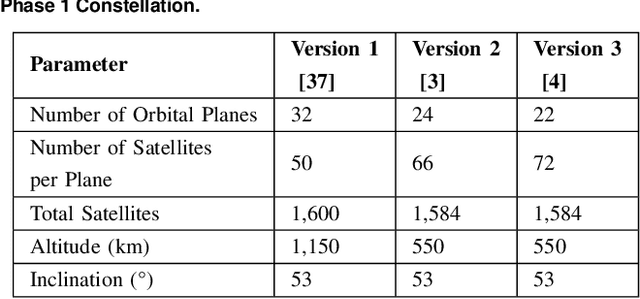

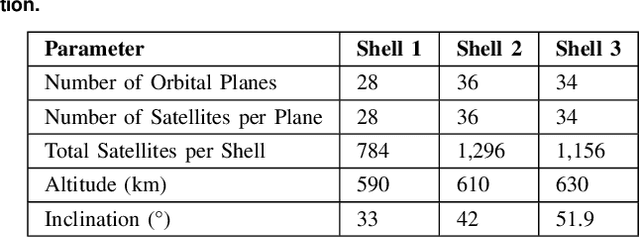
Abstract:In free-space optical satellite networks (FSOSNs), satellites can have different laser inter-satellite link (LISL) ranges for connectivity. Greater LISL ranges can reduce network latency of the path but can also result in an increase in transmission power for satellites on the path. Consequently, this tradeoff between satellite transmission power and network latency should be investigated, and in this work we examine it in FSOSNs drawing on the Starlink Phase 1 Version 3 and Kuiper Shell 2 constellations for different LISL ranges and different inter-continental connections. We use appropriate system models for calculating the average satellite transmission power and network latency. The results show that the mean network latency decreases and mean average satellite transmission power increases with an increase in LISL range. For the Toronto--Sydney inter-continental connection in an FSOSN with Starlink's Phase 1 Version 3 constellation, when the LISL range is approximately 2,900 km, the mean network latency and mean average satellite transmission power intersect are approximately 135 ms and 380 mW, respectively. For an FSOSN with the Kuiper Shell 2 constellation in this inter-continental connection, this LISL range is around 3,800 km, and the two parameters are approximately 120 ms and 700 mW, respectively. For the Toronto--Istanbul and Toronto--London inter-continental connections, the LISL ranges at the intersection are different and vary from 2,600 km to 3,400 km. Furthermore, we analyze outage probability performance of optical uplink/downlink due to atmosphere attenuation and turbulence.
Latency versus Transmission Power Trade-off in Free-Space Optical (FSO) Satellite Networks with Multiple Inter-Continental Connections
Dec 08, 2023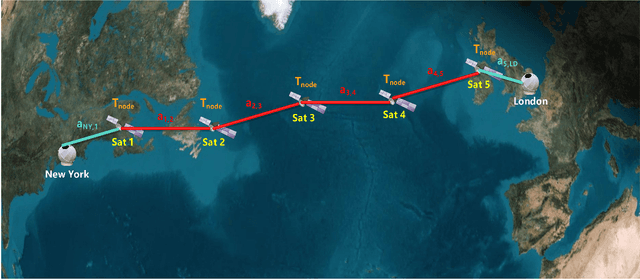
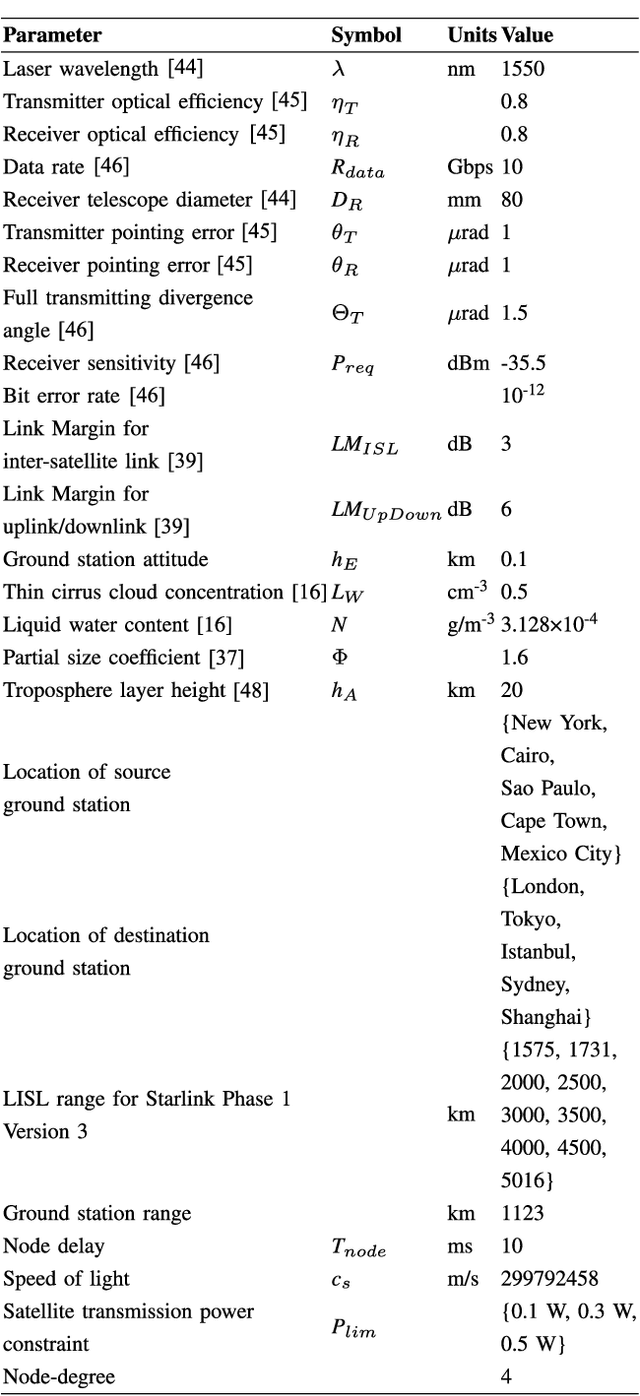
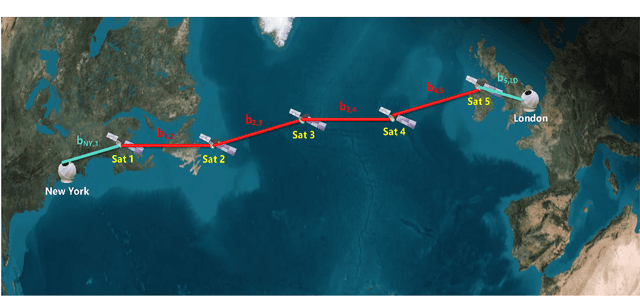
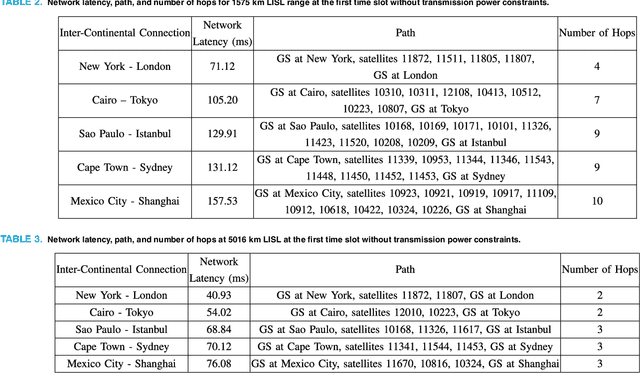
Abstract:In free-space optical satellite networks (FSOSNs), satellites connected via laser inter-satellite links (LISLs), latency is a critical factor, especially for long-distance inter-continental connections. Since satellites depend on solar panels for power supply, power consumption is also a vital factor. We investigate the minimization of total network latency (i.e., the sum of the network latencies of all inter-continental connections in a time slot) in a realistic model of a FSOSN, the latest version of the Starlink Phase 1 Version 3 constellation. We develop mathematical formulations of the total network latency over different LISL ranges and different satellite transmission power constraints for multiple simultaneous inter-continental connections. We use practical system models for calculating network latency and satellite optical link transmission power, and we formulate the problem as a binary integer linear program. The results reveal that, for satellite transmission power limits set at 0.5 W, 0.3 W, and 0.1 W, the average total network latency for all five inter-continental connections studied in this work levels off at 339 ms, 361 ms, and 542 ms, respectively. Furthermore, the corresponding LISL ranges required to achieve these average total network latency values are 4500 km, 3000 km, and 1731 km, respectively. Different limitations on satellite transmission power exhibit varying effects on average total network latency (over 100 time slots), and they also induce differing changes in the corresponding LISL ranges. In the absence of satellite transmission power constraints, as the LISL range extends from the minimum feasible range of 1575 km to the maximum feasible range of 5016 km, the average total network latency decreases from 589 ms to 311 ms.
Link Budget Analysis for Free-Space Optical Satellite Networks
Apr 27, 2022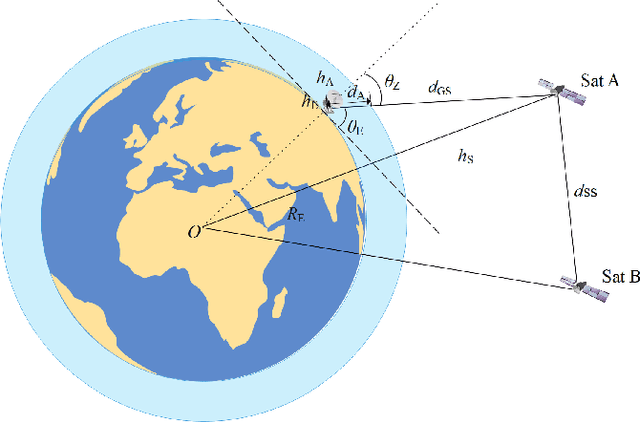
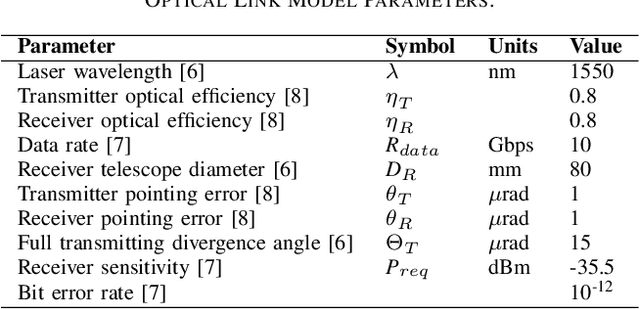


Abstract:Free-space optical satellite networks (FSOSNs) will employ free-space optical links between satellites and between satellites and ground stations, and the link budget for optical inter-satellite links and optical uplink/downlink is analyzed in this paper. The satellites in these FSOSNs will have limited energy and thereby limited power, and we investigate the effect of link distance and link margin on optical inter-satellite link transmission power, and the effect of slant distance, elevation angle, and link margin on optical uplink/downlink transmission power. We model these optical links and compute the results for various parameters. We observe that the transmission power increases when the link distance increases for inter-satellite and uplink/downlink communications, while the transmission power decreases when the elevation angle increases for uplink/downlink transmission. We also observe an inverse relationship between link margin and link distance. Furthermore, we highlight some practical insights and design guidelines gained from this analysis.
Phasing Parameter Analysis for Satellite Collision Avoidance in Starlink and Kuiper Constellations
Sep 28, 2021
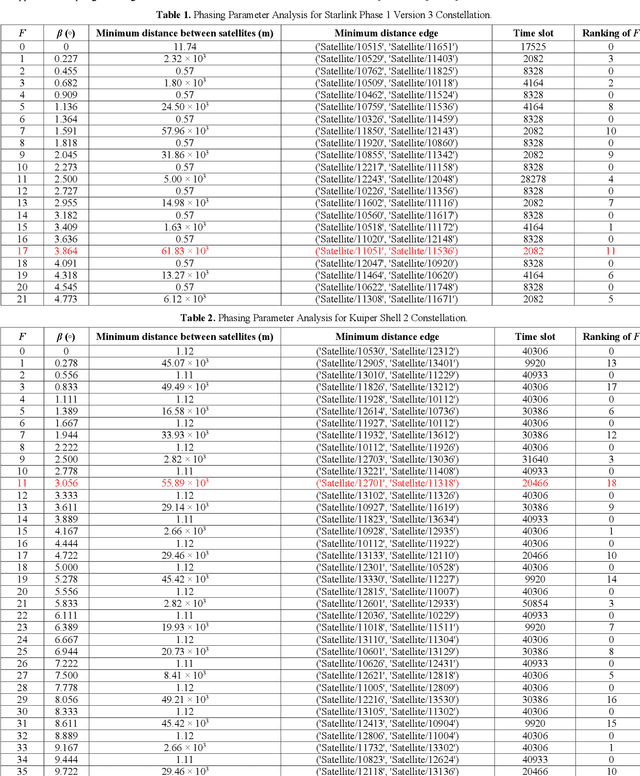
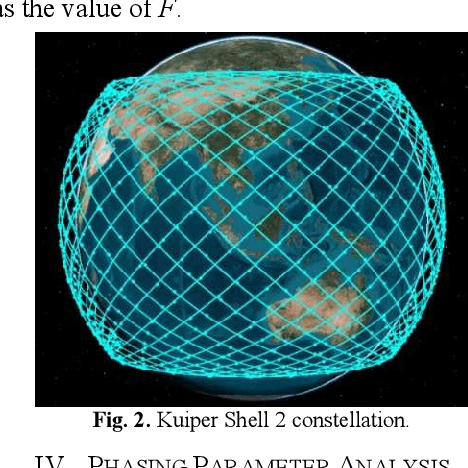

Abstract:The phasing parameter F determines the relative phasing between satellites in different orbital planes and thereby affects the relative position of the satellites in a constellation. The collisions between satellites within the constellation can be avoided if the minimum distance among them is large. From among the possible values of F in a constellation, a value of F is desired that leads to the maximum value of the minimum distance between satellites. We investigate F for two biggest upcoming satellite constellations including Starlink Phase 1 Version 3 and Kuiper Shell 2. No existing work or FCC filing provides a value of F that is suitable for these two constellations. We look for the best value of F in these constellations that provides the maximum value of the minimum distance to ensure intra-constellation avoidance of collisions between satellites. To this end, we simulate each constellation for each value of F to find its best value based on ranking. Out of the 22 and 36 possible values of F for Starlink Phase 1 Version 3 and Kuiper Shell 2, respectively, it is observed that the best value of F with highest ranking is 17 and 11 that leads to the largest minimum distance between satellites of 61.83 km and 55.89 km in these constellations, respectively.
 Add to Chrome
Add to Chrome Add to Firefox
Add to Firefox Add to Edge
Add to Edge